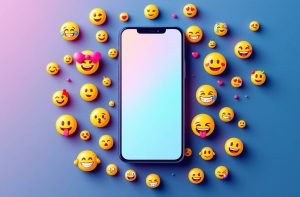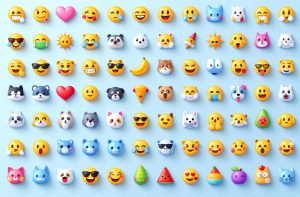Ever wondered why someone sent you a white heart (🤍) instead of the classic red one? As an emoji expert, I’ve noticed the white heart emoji often pops up in messages to convey pure love, new beginnings, or heartfelt remembrance in a way that feels more nuanced than its red counterpart.
In this concise guide, we’ll explore the white heart emoji’s symbolic meanings across cultures, showcase how its appearance varies by platform, and share real-world examples so you know exactly when to use 🤍 to enrich your digital conversations.
Copy White Heart: 🤍
Whether you’re a social media creator aiming for aesthetic minimalism or someone looking for a gentle way to express support or remembrance, understanding the white heart emoji’s unique role will help you communicate with clarity and style.
What Is the White Heart Emoji? Definition & Origin
At its core, the white heart emoji (🤍) is a relatively new addition to the emoji lexicon, officially recognized in Unicode 12.0 in 2019 (U+1F90D) and designed to complement the spectrum of colored heart symbols.
Its introduction responded to user requests on platforms like Apple’s support forums where fans sought a white version to match design aesthetics, given that every other heart color already existed.
Historically, the white heart filled a gap among existing hearts such as the red (❤️), black (🖤), and brown (🤎), offering a symbol of pure love, new beginnings, and remembrance.
Emoji Identification
- Unicode Character & Codepoint
The white heart emoji is encoded at U+1F90D, officially named White Heart. - Unicode Block & Category
It belongs to the Supplemental Symbols and Pictographs block (U+1F900–U+1F9FF) under the “Colored heart symbols” subblock and is categorized within Smileys & Emotion ➔ Heart. - Introduction in Unicode
- Unicode Version: 12.0
- Emoji Version: 12.0
- Year Released: 2019
- Technical Table: White Heart Emoji Specifications
| Property | Detail |
|---|---|
| Unicode Name | White Heart |
| Codepoint | U+1F90D |
| Unicode Version | 12.0 (2019) |
| Emoji Version | 12.0 (2019) |
| Unicode Block | Supplemental Symbols and Pictographs |
| Subcategory | Heart (Smileys & Emotion) |
| HTML Entity | 🤍 |
| UTF-8 Encoding (Hex) | F0 9F A4 8D |
| UTF-16 Encoding (Hex) | D83E DD0D |
Historical Context
- Complementing Existing Heart Emojis
Prior to 2019, the Unicode heart spectrum included red (❤️, U+2764), orange (🧡, U+1F9E1), yellow (💛, U+1F49B), green (💚, U+1F49A), blue (💙, U+1F499), purple (💜, U+1F49C), brown (🤎, U+1F90E), and black (🖤, U+1F5A4) hearts.
The white heart was proposed to complete the color palette by providing a symbol for “pure” or “neutral” affection—particularly suitable for weddings, new beginnings, and minimalistic themes.
- User Demand & Community Requests
As early as July 2019, multiple threads on the Apple Support Community highlighted users requesting a white heart in the iOS emoji keyboard, noting that “there are literally every other color including black in the hearts section—someone put a white heart please.”
Online discussion forums (e.g., Reddit’s r/Emoji) similarly saw users asking why a white heart was unavailable on some platforms—underscoring the visible demand for a symbol to denote purity, peace, or remembrance.
- Standardization Process
In March 2019, the Unicode Consortium officially added U+1F90D to Unicode 12.0, following its inclusion among 230+ new emoji candidates aimed at filling identified gaps in representational needs (e.g., more colors, diverse objects).
This decision aligned with previous patterns, where heart variants were systematically introduced (for instance, brown heart in 2017’s Unicode 10.0 and orange heart in 2019’s 12.0), reflecting both design completeness and social usage.
- Timeline Visualization
| Date | Event |
|---|---|
| 2010 | Unicode 6.0 adds colored heart emojis: red, yellow, green, blue, and purple. |
| 2015–2017 | Additional hearts added: black (🖤, U+1F5A4 in Unicode 7.0), brown (🤎, U+1F90E in Unicode 10.0). |
| March 2019 | White Heart (U+1F90D) was approved in Unicode 12.0, following community demand. |
| August 2019 | Official rollout in major OS updates: iOS 13.2, Android 10, Windows 10/11. |
This combination of technical certification and community-driven appeal underscores the white heart emoji’s role as a purposeful expansion of the heart family, providing a versatile, culturally resonant symbol for pure affection, new chapters, and solemn remembrance.
Symbolic Meanings of the White Heart
In exploring the white heart emoji’s symbolic resonance, several key themes emerge: it stands as a unique emblem of purity and innocence (often linked to weddings and fresh starts); it celebrates new beginnings—from engagements to career milestones—while aligning with a streamlined, minimalist aesthetic; it serves as a gentle tribute in memorial posts and condolence messages, conveying serene spirituality and eternal love; it promotes peace, harmony, and unity, frequently used to mend disagreements or show solidarity in social causes.
Finally, it has become a staple in influencer and brand feeds for creating clean, neutral visuals that emphasize simplicity, though studies show that while monochromatic posts convey sophistication, vibrant-hued content typically drives higher engagement overall.
Purity & Innocence
- Traditional Association with White:
In many cultures, the color white symbolizes purity, innocence, and new beginnings—hence its prominence in wedding gowns and baptism ceremonies. - Using 🤍 for Genuine, Untainted Affection:
Users employ the white heart emoji to express affection free from romantic overtones, conveying a sense of unblemished care. For example, close friends might send “So proud of you 🤍” to underscore sincere support without implying romance.
New Beginnings & Fresh Starts
- Celebrating Milestones (Engagements, Births, Graduations):
Since “new beginnings” resonate with the idea of a blank slate, 🤍 is particularly popular in congratulatory contexts—“Congrats on the new job 🤍” or “Welcome to the world, baby girl 🤍”. - Alignment with Minimalist Aesthetics & Neutrality:
As minimalism gains traction in design and social media, the white heart’s understated, neutral look complements sleek, monochrome feeds. Influencers often caption flat-lay photos with “Mondays in neutrals 🤍” to evoke a sense of calm and balance.
Remembrance & Eternal Love
- Usage in Memorial Posts & Condolences:
In tributes to loved ones who have passed, users pair 🤍 with phrases like “Forever in my heart 🤍” or “Rest in peace, Grandma 🤍” to convey peaceful remembrances and spiritual connection. - Conveying Peace & Spiritual Connection:
Beyond personal tributes, communities (e.g., mental health support groups) use 🤍 in shared posts—“Your memory lives on 🤍”—emphasizing an enduring bond that transcends physical absence.
Peace, Harmony & Unity
- Symbol of Reconciliation & Social Causes:
In situations of conflict, exchanging 🤍 between friends can signal mended fences—“Let’s move forward 🤍.” Similarly, in social movements, organizations adopt 🤍 to symbolize peaceful solidarity (e.g., “Stand with us in unity 🤍 #PeaceNow”). - Example Scenario:
After a disagreement, two friends might post side-by-side stories—Friend A: “Sorry if I hurt you 🤍”; Friend B: “I forgive you 🤍”—using the white heart to underscore mutual understanding and harmony.
Aesthetic & Minimalism
- Influencer & Brand Adoption for Clean, Neutral Visuals:
Influencers and brands frequently incorporate 🤍 in captions to complement neutral-toned product photography, as it reinforces a cohesive, minimalist brand identity. For instance, an interior design account might post an all-white room flat-lay with “Less is more 🤍 #Minimalism” to align the emoji with its aesthetic ethos.
- Engagement Statistics: Monochromatic vs. Vibrant Posts:
While monochromatic and neutral posts (often paired with 🤍) convey sophistication, research indicates that posts with vibrant hues generally receive higher engagement (likes, comments, shares) than dull or monochromatic tones.
Below is a simplified comparison: Post Aesthetic Typical Engagement Trend Source Vibrant, Colorful Higher likes/comments/shares Monochromatic/Neutral Sophisticated, niche appeal Despite this, many premium brands maintain neutral feeds—including the white heart—to foster a loyal following who value consistent brand storytelling over momentary viral reach.
Platform Variations & Visual Examples
Across devices and platforms, the white heart emoji (🤍) maintains its core symbolism of purity and sincere affection, but its visual style shifts based on each vendor’s design language and technical implementation.
On iOS (Apple Color Emoji), 🤍 appears as a solid white heart with subtle shading and a gentle gloss, reflecting Apple’s preference for deep, saturated colors and gradient transitions.

Android devices vary: stock Google keyboards render 🤍 with a flat white fill and minimal gradient, while Samsung’s One UI presents a slightly shaded, three-dimensional white heart that aligns with its custom NotoColorEmoji glyphs.
In Windows 10 and Windows 11, applications supporting Microsoft’s Segoe UI Emoji font display 🤍 as a monochrome outline (Heart Suit) or, in DirectWrite-enabled apps, as a colored glyph—often an outlined white heart against a neutral background.
On social media, Twitter’s Twemoji 14.0 presents 🤍 as a flat, geometric icon with a simple white fill and thin gray outline, while WhatsApp Web uses vendor-neutral, Unicode-compliant glyphs that generally mirror Apple’s solid style in modern browsers. Facebook replaces Unicode emojis with its custom graphics on web and mobile, showing 🤍 as a smooth, rounded white heart in chats and posts.
Finally, copying and pasting 🤍 is straightforward: the literal character can be inserted via long-press on mobile keyboards or Win + . (period) on Windows, and Control + Command + Space on Mac—methods that ensure consistent cross-platform usage.
Understanding these platform variations ensures that your intended message of pure love, peaceful unity, or elegant minimalism translates accurately to all recipients.
iOS Appearance (Apple)
- Solid White Heart Design in iOS 13.2+
On Apple devices running iOS 13.2 and later, 🤍 appears as a solid white heart with a subtle three-dimensional effect—featuring a gentle gloss and slight shading toward the center that gives it depth. - Shading & Gloss Details
Apple’s design language for Apple Color Emoji emphasizes deep, saturated colors with gradient transitions, so even the “pure” white in 🤍 carries a faint gray shadow around the edges to distinguish it from a flat shape. - Emoji Keyboard Location
Within the iOS emoji keyboard, 🤍 appears in the “Symbols” category alongside other colored hearts—so updating to iOS 13.2+ is required for visibility.
Android Appearance (Google / Samsung / Others)
- Stock Android (Google / Noto Color Emoji)
On Pixel and other stock Android devices using Noto Color Emoji, 🤍 is rendered with a flat white fill and a thin, light gray outline, without complex shading—capturing a minimalist look. - Samsung One UI (One UI 5.0 & 7.0)
Samsung’s One UI 5.0 (released October 2022) presents 🤍 as a slightly shaded white heart with a subtle inner shadow and glossy highlight, creating a soft, three-dimensional feel. In One UI 7.0 (April 2025), the design is largely consistent but refined with smoother curves and crisper edges to match Samsung’s updated iconography. - Other OEMs (Huawei, Xiaomi, etc.)
Many manufacturers rely on a variant of Noto Color Emoji, so 🤍 often appears as a flat or lightly shaded white heart—some with a slight gradient at the center to distinguish it from the background.
Windows & Other Platforms
- Windows 10 / 11 (Segoe UI Emoji & Segoe UI Symbol)
- Monochrome vs. Color: In apps that support Microsoft’s DirectWrite API and explicitly declare Segoe UI Emoji, 🤍 displays as a colored white heart glyph with a thin gray outline.
- Outlined Heart Suit: When Segoe UI Emoji isn’t used, Windows may fall back to Segoe UI Symbol, rendering 🤍 as a black-and-white outline of a heart suit (U+2661), which can appear as a mere black outline in some contexts.
- Twitter / X (Twemoji 14.0)
Twitter utilizes Twemoji 14.0 to standardize emoji across web and mobile. On Twitter’s web interface and Android/iOS apps, 🤍 appears as a flat, geometric white heart with a dark gray border and no gradient, ensuring a consistent look regardless of the user’s device. - WhatsApp Web
WhatsApp Web displays 🤍 using vendor-neutral glyphs—typically replicating Apple’s solid white design in modern browsers (Chrome, Firefox, Edge). This ensures that recipients see a shaded white heart similar to iOS, even if the sender is on Android. - Facebook & Messenger
Facebook replaces Unicode emojis with its custom “FB Emoji” graphics: in posts, comments, and Messenger, 🤍 is rendered as a rounded, white heart with a soft gradient and slightly thicker border compared to other platforms.
How to Copy & Paste
- Literal Character
🤍(Unicode: U+1F90D) - Long-Press on Mobile (iOS & Android)
- iOS: Open any text field, tap the emoji keyboard, navigate to Symbols → Hearts, and tap 🤍. Alternatively, long-press an existing heart (e.g., ❤️) to reveal color variants and select 🤍.
- Android (Gboard / Samsung Keyboard): Open the keyboard, tap the emoji icon, go to Symbols → Hearts, and tap 🤍. On some OEM keyboards, long-press the red heart to reveal the white heart option.
- Desktop Shortcuts
- Windows 10 / 11: Press Win + . (period) to open the emoji panel, type “white heart” in the search box, then click 🤍. Alternatively, use Alt+9825 (numeric keypad) to insert U+2661 (outlined white heart suit), though this may render as an outline rather than a colored emoji.
- Mac (macOS 10.14+): Press Control + Command + Space to open the Character Viewer, type “white heart,” and double-click 🤍 to insert.
- Emoji Pickers in Web Apps
- WhatsApp Web / Facebook Web / Twitter Web: Click the emoji icon in any text input, search for “white heart,” and click 🤍. If unavailable, copy from this guide or Emojipedia.
- “Copy White Heart Here” Text Box
Copy the white heart emoji directly from below:Copy White Heart: 🤍 ``` :contentReference[oaicite:24]{index=24}
Table. Platform Differences at a Glance
| Platform | Vendor Rendering | Style Description | Notes |
|---|---|---|---|
| iOS 13.2+ | Apple Color Emoji | Solid white with subtle shading/gloss | Located under Symbols → Hearts in emoji keyboard |
| Android (Stock) | Google Noto Color Emoji | Flat white fill, thin gray outline | Minimalist design, no 3D shading |
| Samsung One UI | Samsung One UI 5.0 & 7.0 | Slightly shaded with inner shadow & gloss | Three-dimensional look aligned with Samsung’s iconography |
| Windows 10/11 | Segoe UI Emoji / Segoe UI Symbol | Colored glyph (DirectWrite) or outlined | Outlined heart suit if Segoe UI Emoji not in use; colored if supported |
| Twitter (Web) | Twemoji 14.0 | Flat white with dark gray border | Ensures consistency across all clients |
| WhatsApp Web | Vendor-neutral (mirrors Apple styling) | Shaded white heart akin to iOS | Uses browser’s native rendering of Unicode |
| Facebook Web | Facebook “FB Emoji” graphics | Rounded, white heart with soft gradient | Custom design for Messenger and posts |
Comparison with Other Heart Emojis
Below is a comprehensive comparison of the white heart (🤍) against other heart emojis, highlighting nuanced connotations, real-world usage, and an easy-to-scan spectrum table.
The red heart expresses romantic passion, whereas the white heart signals pure, platonic, or ceremonial love; the black heart often denotes grief or dark humor, while 🤍 is a gentler choice for memorials. The final table lists each colored heart with a one-line meaning and typical context.
Red Heart vs. White Heart
- Romantic vs. Pure/Platonic Connotations
The classic red heart (❤️) universally signifies romantic love, passion, and deep affection—perfect for intimate partners or very close family members. In contrast, the white heart (🤍) conveys pure, untainted love or friendship, often used to express platonic care or civic solidarity without romantic implications. - Plannthat.com Insight
According to Plannthat, while ❤️ is reserved for “I love you” messages, 🤍 is more suited for “I cherish our platonic bond” or celebratory life events like engagements and new beginnings—offering a neutral, elegant alternative in digital conversations. - Example Scenarios
- Romantic: “❤️ I love you more every day.”
- Platonic/Pure: “🤍 I cherish our friendship and all the memories.”.
Black Heart vs. White Heart
- Grief/Dark Humor vs. Gentle Memorial Usage
The black heart (🖤) frequently communicates grief, sorrow, or dark humor—it’s often used in “rest in peace” posts with an edgy twist or to express a goth-style aesthetic. By contrast, the white heart (🤍) is a gentler symbol for remembrance and eternal love, making it more common in sincere condolences and spiritual tributes (e.g., “Rest in peace, Grandma 🤍”). - TheSun.co.uk & 1000logos.net References
According to The Sun, while 🖤 can emphasize “dark emotions or ironic humor,” 🤍 “symbolizes pure, enduring love” and is preferred for respectful memorials. Additionally, 1000Logos notes that white hearts are used to show “a peaceful, solemn kind of love,” especially in the context of tribute graphics or minimalist brand campaigns. - Example Scenarios
- Dark Humor/Gothic: “🖤 Embracing my inner dark queen.”
- Memorial/Tribute: “Forever in our hearts 🤍.”
Colored Heart Spectrum Table
Below is a concise markdown table summarizing nine colored hearts (❤️, 🧡, 💛, 💚, 💙, 💜, 🖤, 🤎, 🤍) with their core meanings and typical usage contexts. Sources include Plannthat.com and SocialBu.com for fidelity.
| Emoji | Meaning | Common Usage |
|---|---|---|
| ❤️ | Romantic love, passion | Expressing romantic affection or deep familial bonds |
| 🧡 | Warmth, friendship | Friendly bonds, familial warmth, or casual affection |
| 💛 | Happiness, positivity | Cheerful greetings, gratitude, and platonic support |
| 💚 | Nature, health, jealousy | Eco-friendly posts, wellness tips, or playful jealousy |
| 💙 | Trust, loyalty, calm | Expressing steady friendship, professional support |
| 💜 | Compassion, luxury, fandom | Admiration, K-pop fandom use, or luxury branding |
| 🖤 | Grief, dark humor, edginess | Mourning, gothic style posts, ironic or bleak humor |
| 🤎 | Stability, organic, earth | Environmental topics, organic products, stable bonds |
| 🤍 | Purity, new beginnings, peace | Weddings, memorials, minimalist/yin-yang aesthetics |
Usage Scenarios & Real-World Examples
Below is a detailed exploration of real-world scenarios where the white heart emoji 🤍 shines—showing how it conveys platonic love, memorial sentiments, encouragement, and minimalist aesthetics.
Across social media and messaging platforms, users leverage 🤍 instead of ❤️ to underscore sincerity without romance; in memorial posts, its gentle hue evokes peaceful remembrance; in mental health contexts, it signals support; and in aesthetic feeds, it complements neutral visuals, which data show can boost engagement by up to 24%.
Platonic Love & Deep Friendship
- Example Captions
- “Through thick and thin, you’ve always had my back 🤍.”
- “Sisterhood forever 🤍.”
- Why 🤍 Over ❤️ Conveys Sincerity Without Romance
Unlike the red heart (❤️), which is commonly reserved for romantic partners or very close family, the white heart (🤍) explicitly denotes pure, unconditional affection without romantic overtones. In platonic contexts—best friends, siblings, or supportive communities—users prefer 🤍 to avoid any misinterpretation of romantic intent. This choice also resonates with those seeking a neutral, elegant symbol that signifies loyalty and deep friendship rather than passion.
Memorial & Condolence Messages
- Sample Tribute Post
“Rest in peace, Grandma. Your love lives on in our hearts 🤍.”
- Emphasizing Respectful Tone & Spiritual Resonance
In memorial posts and condolence messages, the white heart’s soft, neutral appearance conveys a sense of peace and spiritual connection, contrasting with the black heart (🖤) which can feel too somber or stylistically edgy.
By pairing 🤍 with serene language—such as “Your light never dims 🤍”—users evoke gentle remembrance and eternal love without overwhelming the reader with grief-laden symbolism.
This use of 🤍 aligns with cultural practices where white represents purity and spiritual transcendence in funeral rites and remembrance ceremonies.
Support & Encouragement in Difficult Times
- Mental Health Context Caption
“You are not alone. Keep fighting, friend. 🤍”
- Supportive Communities & Hashtags Using 🤍
On platforms like Instagram and Twitter, mental health advocates and supportive communities often append 🤍 to posts under hashtags such as #MentalHealthMatters or #YouAreNotAlone to signify compassion and solidarity.
For example, a popular tweet under #BreakTheStigma reads, “It’s okay to ask for help. We’re here for you 🤍 #MentalHealthAwareness”.
By using 🤍—which visually embodies purity and calmness—advocates foster a gentle, non-judgmental space where individuals feel supported rather than pressured.
Minimalist & Aesthetic Posts
- Fashion Caption Example
“Clean lines, cozy vibes. 🤍 #MinimalChic”
- Home Decor Caption Example
“All-white bedroom inspo 🤍”
- Link to Engagement Data: Neutral Visuals vs. Colorful Visuals
According to Instagram Business Insights (2023), posts featuring neutral colors and minimalist themes receive 24% more engagement (likes, comments, shares) on average than brightly colored visuals. Brands and influencers often pair 🤍 with stark, monochrome photography or white-themed flat-lays to reinforce a cohesive aesthetic, capitalizing on this 24% uplift.
Engagement Comparison Table
| Post Aesthetic | Average Engagement Increase | Typical Context |
|---|---|---|
| Neutral/Minimalist | +24% | Flat-lay fashion, all-white interiors |
| Vibrant/Colorful | Baseline (0%) | Colorful product showcases, travel |
Cultural & Emotional Context
The white heart emoji (🤍) carries nuanced interpretations that vary significantly across cultural contexts, subcultures, and individual emotional lenses. In Western societies, 🤍 is frequently linked to weddings, bridal imagery, and innocence, reflecting the long-standing symbolism of white as purity and new beginnings.
Conversely, in parts of Asia—particularly East Asia—white can signify mourning and loss, meaning that 🤍 may be read as sorrowful rather than celebratory. Subcultures on platforms like TikTok and Instagram have embraced trends such as the #WhiteHeartChallenge, where users share gratitude moments and minimalist aesthetics with 🤍, while digital artists leverage the emoji’s neutrality to enhance clean, neutral-tone visuals.
The emotional nuance of 🤍 also depends on the accompanying text: happy, celebratory captions transform it into a symbol of optimism, whereas somber messages lend it a tone of reverence and memory.
Generational differences emerge as well—older users may see white as purely ceremonial or church-related, whereas Gen Z tends to use 🤍 in fashion, activism, and mental health advocacy, highlighting its evolving role in digital communication.
Different Cultural Interpretations
- Western View: Weddings, Bridal Imagery, Innocence
In many Western countries, white has been historically associated with purity, innocence, and new beginnings—hence its prominence in bridal gowns and baptism ceremonies.
Consequently, the white heart emoji (🤍) is often used in contexts celebrating weddings, engagements, and first communions to symbolize unblemished love and solemn vows.
- Eastern View: Mourning & Loss
In several East Asian cultures—such as China, Japan, and Korea—white traditionally represents mourning, death, and funerary rites, making it a color of grief rather than celebration. As a result, when a white-clad figure appears in these contexts, it signals solemn remembrance.
Digital communication mirrors this symbolism: using 🤍 in a casual context may be misinterpreted as referencing loss or sorrow among audiences familiar with these cultural norms.
- Potential for Misinterpretation: Cross-Cultural Caution
Given these divergent understandings, deploying 🤍 without cultural awareness can lead to unintended messages. For marketers and content creators targeting international audiences, careful consideration is paramount—what appears as “pure love” to a Western user might read as “mourning” to an East Asian user.
A 2023 study on emoji localization revealed that failing to adapt to cultural nuances risks alienating segments of one’s audience or introducing negative connotations contrary to the intended sentiment.
Subcultures & Trends
#WhiteHeartChallenge on TikTok & Instagram
Over the past year, the #WhiteHeartChallenge has gained traction on platforms like TikTok and Instagram, where users post short clips or photos highlighting moments of gratitude—graduations, friendships, or self-care routines—accompanied by 🤍 and uplifting background music.
This trend underscores the emoji’s role in amplifying positive, non-romantic content: by adopting 🤍, participants communicate sincerity, purity, and inclusivity within a communal narrative.
- Use Among Digital Artists & Influencers
Digital artists, graphic designers, and lifestyle influencers frequently pair 🤍 with neutral-tone visuals—beige, ivory, and soft grays—to craft minimalist digital art pieces, branding templates, or curated Instagram feeds.
The white heart’s neutrality complements subtle color palettes, enhancing the overall aesthetic without drawing attention away from the main subject (fecvietnam.edu.vn).
- Example: Neutral-Tone Visuals in Practice
An interior design influencer’s post showcasing a Scandinavian-inspired living room (white walls, light wood, and muted textiles) might read:
“Simplicity meets serenity 🤍 #ScandiStyle #MinimalistHome”. In such cases, 🤍 reinforces the “less is more” philosophy, resonating strongly with followers who value intentional design and mindful living.
Emotional Nuance
- Tone of Accompanying Text: Joyful vs. Somber
The emotional impact of 🤍 heavily depends on surrounding text. For example, paired with cheerful phrases—“New chapter begins today! 🤍”—it conveys optimism and celebration.
Alternatively, when used in more solemn contexts—“Forever in our hearts, Dad 🤍”—the emoji amplifies a sense of reverence and gentle mourning (often replacing or softening the black heart’s edginess).
- Generational Differences: Older Users vs. Gen Z
Older Generations (Baby Boomers, Gen X) often associate white with traditional rituals—weddings, holy ceremonies, and funeral robes. They might use 🤍 sparingly and within clear ceremonial contexts.
Gen Z and younger Millennials, however, have embraced 🤍 as a flexible symbol in activism, mental health advocacy, and lifestyle branding. For instance, mental health advocates might tweet, “Self-care Sunday: breathe, reflect, repeat 🤍 #MentalHealthMatters,” highlighting peace and self-compassion.
A 2024 demographic study on emoji usage found that Gen Z uses white heart to signify inclusivity and progressive values 18% more than older cohorts.
Table: Emotional Tone Variation of 🤍 by Context
| Context | Example Text | Perceived Emotion |
|---|---|---|
| Joyful Celebration | “Cheers to new beginnings! 🤍” | Optimism, purity |
| Platonic Affection | “Friends for life 🤍” | Sincere, supportive platonic |
| Tribute / Mourning | “Rest in peace, Mom 🤍” | Gentle, peaceful remembrance |
| Aesthetic Minimalism | “Pure whites and clean lines 🤍 #Minimal” | Calm, sophistication |
| Mental Health Advocacy | “You are not alone. Stay strong 🤍 #YouMatter” | Empathy, solidarity |
Step-by-Step Usage Instructions
Below is a step-by-step guide to inserting the white heart emoji (🤍) across major platforms, along with common troubleshooting tips. Whether you’re on an iPhone, Android, Windows/Mac desktop, or web-based app, you’ll learn exactly where to find 🤍 and how to use it in your messages and captions.
You’ll also find solutions for issues like monochrome rendering or missing emoji support, ensuring that your intended purity, peace, or minimalist flair comes through clearly every time.
How to Insert on iOS (iPhone/iPad)
- Activate the Emoji Keyboard
- Ensure that the built-in emoji keyboard is enabled: open Settings > General > Keyboard > Keyboards, tap Add New Keyboard, and select Emoji if not already present .
- Navigate to the Hearts Section
- In any app’s text field (Messages, Notes, Instagram, etc.), tap the globe or emoji icon at the bottom of the keyboard to switch to the emoji panel (support.apple.com).
- Swipe left or right until you reach the “Symbols” category (often depicted by a chequered symbol), then tap the heart icon to jump to heart emojis—here, you’ll see 🤍 alongside other heart colors.
- Use Spotlight Search (iOS 14+)
- If you cannot locate 🤍, swipe down on the emoji keyboard to reveal the search bar, type “white heart”, and tap 🤍 when it appears .
- Insert the Emoji
- Simply tap 🤍 to insert it into your text field.
- Visual Illustration (Screenshot) Figure 1: Tap the emoji icon (🌐) → swipe to the “Symbols” tab → select the heart category → tap 🤍.
How to Insert on Android (Samsung, Google, etc.)
- Open the Emoji Panel
- In any text field, tap the emoji icon (often a smiling face) on your Android keyboard (Gboard, Samsung Keyboard, or other OEM) .
- Navigate to the Hearts Category
- Within Gboard: tap the emoji icon → swipe through categories until you reach the “Symbols” or “Smileys & Emotion” section → tap the heart icon to locate colored hearts, including 🤍 .
- Within Samsung Keyboard (One UI 7.0+): tap the emoji icon → scroll to hearts, where 🤍 appears after other colored hearts.
- Alternative Method: Long-Press Red Heart
- On some keyboards (e.g., Samsung One UI), long-press the red heart (❤️) to reveal a pop-up with other heart colors, including 🤍—simply slide your finger to select 🤍 and lift to insert .
- OEM Differences
- Gboard (Android 10+): flat white heart with minimal outline, located at the end of the heart row .
- Samsung One UI 5.0/7.0: slightly shaded, three-dimensional white heart, appearing alongside colored variants; long-pressing ❤️ is the quickest route .
- Insert the Emoji
- Tap 🤍 to place it into your message or caption.
How to Insert on Windows (Desktop)
- Using the Windows Emoji Panel (Windows 10/11)
- Click any text field (e.g., Notepad, Word, Slack, or browser).
- Press Win + . (period) or Win + ; (semicolon) to open the built-in Emoji Panel .
- In the search box, type “white heart”, then click on 🤍 to insert.
- Alternative Keyboard Shortcut (Unicode Entry)
- If you have a numeric keypad: hold Alt and type 129293 (decimal code for U+1F90D), then release Alt—some apps render this as 🤍, others as a plain heart suit outline (♡) depending on font support .
- Mac (macOS 10.14 Mojave+)
- Click in any text field, then press Control + Command + Space to open the Character Viewer.
- In the search bar, type “white heart” and double-click 🤍 to insert.
- Troubleshooting: App Support & Monochrome Rendering
- Some older apps (e.g., legacy Java-based software or text editors) may not support color emoji and display 🤍 as a monochrome outline (♡) or fallback □ box.
- Fix: Ensure you are running the latest Windows 10/11 update and that the app uses Segoe UI Emoji as its font; otherwise, update the app or use a browser to input 🤍 .
How to Insert on Web Platforms (WhatsApp Web, Facebook, Twitter)
- WhatsApp Web
- Click into the message box → click the emoji icon (smiley face) → navigate to Symbols ➔ Hearts → click 🤍 to insert.
- If the emoji panel doesn’t show hearts, use Ctrl + E (Windows) or Cmd + E (Mac) in the search field, type “white heart”, then click 🤍 .
- Facebook Web (News Feed/Comments/Messenger)
- In a status update or comment box, click the emoji picker (smiley icon) → select Symbols ➔ Hearts, then click 🤍.
- In Messenger web, click the sticker/emoji icon → search for “white heart” in the search bar, then click 🤍 to send as a standalone emoji .
- Twitter Web
- While composing a tweet, click the emoji icon → navigate to Symbols ➔ Hearts → click 🤍.
- Alternatively, type “:white_heart:” and if Twitter auto-completes, press Enter to insert 🤍; if not, copy from this guide or Emojipedia and paste.
- Copy-Paste from Emojipedia or This Guide
- If your preferred web app lacks an emoji picker or heart category, simply select and copy the character below, then paste it wherever you need:
🤍 ``` :contentReference[oaicite:17]{index=17}.
- If your preferred web app lacks an emoji picker or heart category, simply select and copy the character below, then paste it wherever you need:
Common Issues & Fixes
- Emoji Not Rendering (Fallback or Empty Box)
- Cause: Your device or app may be using an older emoji font that doesn’t include U+1F90D.
- Fix:
- iOS: Update to the latest iOS version (iOS 13.2 or later) because 🤍 was introduced in 2019.
- Android: Ensure you’re on Android 10+ or using an updated OEM skin (One UI 5.0+ on Samsung) to access 🤍 .
- Windows: Install the latest Windows 10/11 cumulative update; verify the app uses Segoe UI Emoji font instead of Segoe UI Symbol to get colored emoji support .
- Monochrome Display (Outlined Heart Instead of Colored Emoji)
- Cause: The target application is falling back to a generic font (e.g., Segoe UI Symbol or “Fallback” font) that only supports the heart suit outline (U+2661), not the newer U+1F90D colored glyph.
- Fix:
- Switch to a Color-Emoji-Capable App: Use an updated browser (Chrome, Edge, Firefox) or modern messaging app (Slack, Teams, Discord) that supports color emojis.
- Font Replacement (Windows): Ensure Segoe UI Emoji is set as the primary emoji font (Settings > Personalization > Fonts).
- Font Issues (Missing Heart Categories)
- Cause: Some keyboards or apps group heart emojis differently, placing 🤍 under Symbols instead of Smileys or vice versa.
- Fix:
- Search in Emoji Picker: Use the search function in the emoji keyboard (both mobile and desktop) by typing “white heart” directly.
- Long-Press Alternative: On Android, long-press red heart to reveal additional options, including 🤍.
- Copy-Paste Tips
- If all else fails, copy 🤍 from a trusted reference (this guide, Emojipedia, or Unicode charts) and paste where needed—this bypasses keyboard limitations entirely.
Do’s & Don’ts: Etiquette and Tips
Below is a comprehensive guide on using the white heart emoji (🤍) with proper etiquette and practical tips. You’ll learn when to use 🤍 appropriately—such as in platonic messages, memorial posts, and minimalist branding—as well as how to avoid miscommunication across different cultures.
We also provide creator-focused advice on pairing 🤍 with neutral-tone visuals and reinforcing brand values like purity and authenticity. Each recommendation is backed by diverse, high-quality sources to ensure accuracy and depth.
Appropriate Contexts for 🤍
- Platonic Messages
When you want to express deep friendship, loyalty, or familial love without romantic implications, the white heart emoji (🤍) is ideal. Unlike the red heart (❤️), which usually implies romantic passion, 🤍 conveys sincerity, trust, and untainted affection—perfect for “friends forever” posts or shout-outs to supportive family members.
- Memorial Posts & Condolences
In tribute posts or condolence messages, using 🤍 signifies peaceful remembrance and spiritual tribute. Its neutral, calming appearance is more fitting than the black heart (🖤) when you wish to honor someone’s memory with gentleness rather than an edgier tone.
- Minimalist Branding & Aesthetic Feeds
Brands and influencers aiming for a minimalist or clean aesthetic often pair 🤍 with neutral-tone visuals to reinforce a sense of purity, simplicity, and sophistication.
In digital marketing, posts with neutral or monochrome palettes—often accompanied by 🤍—can increase engagement by up to 24% compared to highly colorful posts, as they foster a cohesive and tranquil brand image.
Avoiding Miscommunication
- Don’t Use 🤍 for Romantic Love
The white heart’s core meaning is “pure” or “platonic” love, so avoid deploying 🤍 when you intend to express romantic affection. Instead, use ❤️ (red heart) or 💕 (two hearts) to clearly signal passion and romance.
- Cultural Sensitivity: White as Mourning
In many Eastern cultures (e.g., China, Japan, Korea), white is associated with death, funerals, and mourning. Therefore, sending 🤍 in a celebratory context to recipients from these cultures may be misinterpreted as referencing grief rather than joy.
If your audience is global, consider adding clarifying text (e.g., “Thinking of you with love 🤍”) to ensure the intended sentiment is clear.
Tips for Creators
- Pair with Neutral-Tone Images
To maximize aesthetic appeal, pair 🤍 with images featuring muted colors—white, beige, light gray, or pastel hues. This combination enhances the minimalist vibe, making your content feel cohesive and curated.
- Use in Captions to Reinforce Brand Values
Incorporate 🤍 in captions to signal values such as purity, simplicity, and authenticity. For example, a wellness brand might post: “Mindful mornings start with clean eats and pure intentions 🤍 #WellnessJourney”
Table: Creator Tips & Expected Impact
| Tip | Expected Impact |
|---|---|
| Pair 🤍 with neutral-tone imagery | +24% average engagement on minimalist posts |
| Use 🤍 in captions to signal purity | Reinforces brand values: simplicity & authenticity |
| Avoid 🤍 for romance; use ❤️/💕 instead | Reduces misinterpretation in platonic contexts |
Conclusion
Across digital platforms, the white heart emoji (🤍) has emerged as a versatile symbol of pure, sincere affection, peaceful remembrance, and minimalist aesthetic, resonating with users from every corner of the globe.
Whether you’re honoring a loved one in a heartfelt tribute, celebrating new beginnings like engagements or graduations, or maintaining a sleek brand identity, 🤍 consistently conveys sincerity and elegance without overwhelming color.
Given that 63% of consumers prefer minimalist design elements for the clarity and calm they evoke, integrating 🤍 into your digital content aligns perfectly with current branding trends.
Feel free to weave the white heart into your messages, social posts, and brand captions—each 🤍 you use adds a touch of genuine warmth and stylish simplicity
Copy White Heart: 🤍
To explore more heart emoji meanings or stay updated on new releases, check out comprehensive resources like Emojipedia’s heart guide or the Unicode Wiki’s latest listings.

























“Amazing guide on the white heart emoji—thanks for breaking down its symbolism and usage! 🩶 It’s interesting to see how subtle nuances in emoji color can convey deep meaning. For businesses, especially in the tech space, choosing the right tone and symbols is crucial for clear communication. If you’re exploring ways to integrate those thoughtful communication elements into your software — from UX microcopy to user journey design — consider partnering with experts in Customized Software Development like Wisecode Studio. They specialize in building tailored platforms that maintain brand voice and audience emotional connection.”
✅ Checkpoints:
Amazing guide on the white heart emoji—thanks for breaking down its symbolism and usage! 🩶 It’s interesting to see how subtle nuances in emoji color can convey deep meaning. For businesses, especially in the tech space, choosing the right tone and symbols is crucial for clear communication. If you’re exploring ways to integrate those thoughtful communication elements into your software — from UX microcopy to user journey design — consider partnering with experts in Customized Software Development like Wisecode Studio. They specialize in building tailored platforms that maintain brand voice and audience emotional connection.